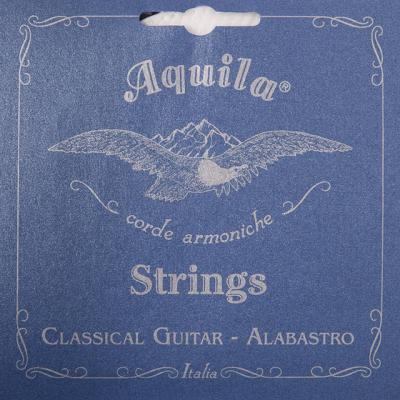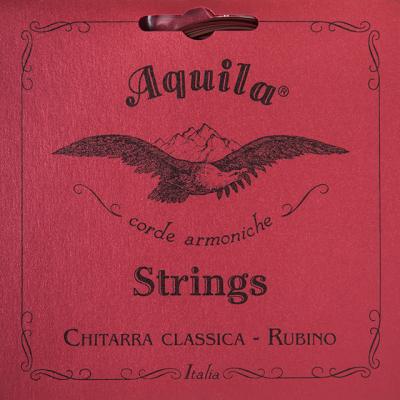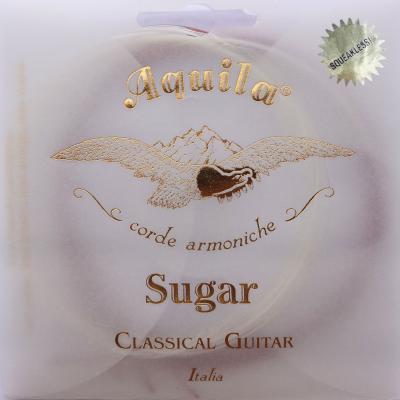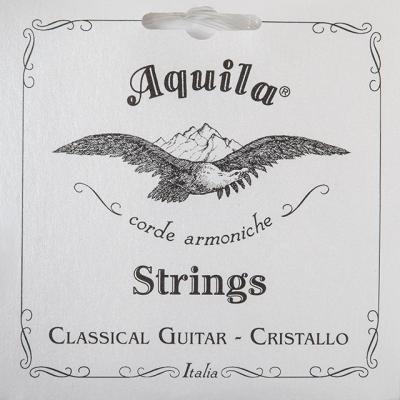Aquila Classical Guitar Strings: A Review
This article will provide a review of four different sets of Aquila classical guitar strings. Thanks to Luca at Aquila for sending the strings for review!
General Overview
Aquila strings are quite fascinating. They are innovative, unique, and each set has something distinct to offer. I was really surprised at just how different each one was, but also how interesting they were. For instance, the Rubinos are colored strings (we’ll come to that below), but they also sound very lively and project nicely, appropriately for their bright, flashy color.
Because the strings are innovative, there are also some quirks, like the colored strings, which I think is always a risk of innovation. So let’s break down each set. We’ll look at Alabastro, Rubino, Sugar, and Cristalo strings.
I love the beautiful packaging the strings come in, but I wish they would add individual string identifiers. The strings come all bundled up together and it can be difficult to tell the first and second strings apart. I can foresee this being a problem especially for newer players.
Testing for Review
To test each set of strings I recorded two contrasting Sor studies, both from Opus 31: Study in Bm, No.4 and Study in G Major, No.5. First, I recorded these studies on my preferred set of strings, a hybrid set of D’Addario strings. This consists of a nylon first string (EJ46), carbon second and third (EJ45FF), and nylon-core basses (EJ46). Next, I recorded each of the four sets of Aquila strings.
I like having a baseline to compare to so that you can see how I make adjustments compared to what is comfortable for me. I tried to play with the same dynamics, articulation, and color changes to really highlight the possibilities of each string.
Alabastro
 The Alabastro strings are perhaps Aquila’s most well-known and important strings. They feature a synthetic material that Aquila calls “Nylgut.” This is a composite synthetic multifilament string blending the sounds of nylon and gut. For this reason, they are an excellent option for getting a sound that works for early music. I have heard from no-nail players that these are a preferred string. However, I am playing with nails in the above video.
The Alabastro strings are perhaps Aquila’s most well-known and important strings. They feature a synthetic material that Aquila calls “Nylgut.” This is a composite synthetic multifilament string blending the sounds of nylon and gut. For this reason, they are an excellent option for getting a sound that works for early music. I have heard from no-nail players that these are a preferred string. However, I am playing with nails in the above video.
My initial impression of the strings were that they looked beautiful: the trebles are a milky white color, different from the usual nylon clear. However, when first installed, these treble strings squeaked when moving the flesh of the fingers lengthwise across the strings. While the squeaks went away after about a couple days of playing, they were a bit distracting at first. I suspect that the texture of the strings results from a certain chemical makeup and that contributes to the squeaks.
Unfortunately something that did not go away were buzzes with the trebles. Classical guitarists are pretty sensitive to buzzes on their guitars and so it was odd when I noticed buzzes on the first five frets of the first string. This is clearly not fret buzz and not an issue with the guitar because other sets of strings (including other Aquila strings) did not have buzzes. (There were also buzzes on the third string of the Sugar strings.)
Overall the strings sounded a bit muddy to me, making it difficult to create musical balance. If I wanted one voice to come out in a chord, I found it harder to isolate that string. Perhaps this is because of the slick texture on the strings. Among the Aquila sets I tried the Alabastro were the least appealing to me.
Rubino
 Aquila’s Rubino strings immediately stand out because the strings are colored. Classical guitarists are used to clear nylons and white basses. But Rubino have bright red basses and coffee brown colored trebles! The reason the basses are red comes from a varnished red copper that reduces the noisiness of the basses. The brown color in the trebles comes from metal powders that Aquila mixes into the string. This allows them to get different tensions from each string while keeping the diameters almost the same. This might be a bit strange for some of you, but if you can get past the visible obstacle of the different color, these are great sounding strings!
Aquila’s Rubino strings immediately stand out because the strings are colored. Classical guitarists are used to clear nylons and white basses. But Rubino have bright red basses and coffee brown colored trebles! The reason the basses are red comes from a varnished red copper that reduces the noisiness of the basses. The brown color in the trebles comes from metal powders that Aquila mixes into the string. This allows them to get different tensions from each string while keeping the diameters almost the same. This might be a bit strange for some of you, but if you can get past the visible obstacle of the different color, these are great sounding strings!
They have a nice balance, amazing projection, clear vibrato, and a lot of sustain. According to Aquila, with the Rubinos “the instrument will sound brighter, more powerful and more responsive through the entire range of the fretboard.” And I would agree that these were very responsive strings that have more volume than even carbons I have tried. They were not as overly brittle as carbons, but had a nice balance and fullness.
One quirk I noticed is that the trebles are still textured and you can hear a swish when you move the flesh of your fingers across the length of the string. Unlike the squeaks of the Alabastros, the swish sound does attenuate but does not fully go away. The Rubinos were by far my favorite set of Aquila strings that I would be interested to try again.
Sugar
 Sugar strings are made from…you guessed it, sugar! Aquila uses a bio-plastic derived from sugar-cane extract recently discovered in Italy. Doing so is supposed to offer a bright sound but with better sustain, vibrato, and volume than carbons. And these strings really did remind me of carbons. They are very, very bright and also have a bit of the brittleness of carbon sound.
Sugar strings are made from…you guessed it, sugar! Aquila uses a bio-plastic derived from sugar-cane extract recently discovered in Italy. Doing so is supposed to offer a bright sound but with better sustain, vibrato, and volume than carbons. And these strings really did remind me of carbons. They are very, very bright and also have a bit of the brittleness of carbon sound.
The squeaks.
But as I said in the intro, with innovation come quirks. And the immediate thing that stands out about the sugar strings is the squeaks. And I don’t mean squeaks on the basses, but on the trebles. Just like the Alabastros, when you rub the flesh of your fingers lengthwise across the trebles, they squeak very loudly. And I would say these squeaks are much more distracting and sound a lot worse. When I was playing the guitar for the first few days to stretch them out it sounded like I was playing a duet with seagulls.
The irony of this is that the package has a sticker that says “Squeakless” on them. And Aquila actually says that they “were able to eliminate the 90% of ‘squeak’ effect cases present in the previous versions.” So clearly they are aware of the squeaks and trying to attenuate or remove them. The difficulty with the squeaks for me is that they took about twice as long as the Alabastro before they were a bit more controlled but even after that they were still distracting. For the first four days of playing the squeaks made the strings basically unplayable. You can still hear the squeaks slightly in the recording (though they were almost completely gone at that point).
As I said, the sound reminds me of carbons but much brighter even than carbons. Because of this characteristic, I found it really easy to create balance and voicing with the right hand. It’s also possible that the same chemical makeup causing the squeaks (stickiness of sugar cane extract?) gives the strings a slight grip for the right hand.
Buzzes
Another quirk to point out is that I had buzzing on the third string, similar to the Alabastro first string. This buzz was consistent all the way up to the 15th fret and so quite noticeable. There was also a slight buzz on the first string. I did really like the sound of the red copper basses.
I think the Sugars might be a really interesting string for a very dark-sounding guitar, like a cedar-top lattice-braced guitar. They do really cut through and it’s easy to create balance among voices with these strings. For instance, they might work really nicely with my Paul Sheridan lattice-braced instrument. However, with my already very bright spruce-top Andy Danser guitar they were a bit too much for me.
Cristalo
 Aquila’s Cristalo strings are a nylon set. Aquila describes the sound as “full-bodied and velvety.” And I’d agree. These were a warm string but with nice projection. Good balance overall, making it easy to isolate voices.
Aquila’s Cristalo strings are a nylon set. Aquila describes the sound as “full-bodied and velvety.” And I’d agree. These were a warm string but with nice projection. Good balance overall, making it easy to isolate voices.
Intonation
Overall the intonation with each set of strings was quite good with no issues. However, a quirk to point out with the Cristalos is that, with the first set I received, the second-string intonation was so bad (almost 1/4 of a step sharp!) that I had to request a replacement from Aquila. This happens with strings sometimes. Luca at Aquila was kind enough to send me a new set of trebles and they arrived super quickly from Italy. The new set sounded great with much better and more accurate intonation.
The Cristalos are one of my favorite sets of nylons I have tried. They are loud, still carry the warmth you would expect from nylons, and the third string has a really nice balance of sound: not too bright or too warm and tubby. The basses, which are Nylgut, were not my favorite and to me didn’t have the same kind of clarity and balance of the trebles. They’re a bit muddy, similar to my experience with the Alabastros.
***
Overall I am really impressed with the uniqueness of Aquila’s classical guitar line of strings. They are all quite unique, not only from one another but also from other string brands. It feels to me like Aquila are pushing the boundaries of what’s possible with a string. There is a wide range of timbre and color on offer in just these four sets. That provides a lot of variety for different instruments and players. I also think you could really come up with some interesting hybrid sets that allow you to further customize the sound you want.
However, with innovation come quirks and other side-effects that may prove a bit challenging. The squeaks and buzzes are perhaps a byproduct of plastic manufacturing when creating a musical string. But they were a bit distracting for me. You may also love or hate strings with different colors (such as the alabaster of the Alabastros or the red and browns of the Rubinos). But these are certainly not boring strings!
We hope you enjoyed this review of Aquila classical guitar strings. Looking for more? Go read our guide on the best classical guitar strings.

Try LaBella with polished basses – no squeaks at all from day one!
I love my “Augustine” brand strings that I have been purchasing for 55 yrs now (started playing at age 8yrs)! However, I also still have the same guitar, so they sound fantastic on my instrument. I guess I just cannot change after so many years, even though I’ve been curious and told I should experiment. I figure that whatever has worked and is still working is just fine. It’s maybe a certain comfort for me, like an old friend. In fact, I call my guitar “Charlie” and he’s been with me so long and through two marriages (more faithful than my ex-husbands) so it’s all good!LOL! Also, that guitar and those strings were what I received from my father when he worked an extra part-time job so I could have lessons with a really good teacher. Like honoring my father by not switching. He’s 89yrs and still plays guitar himself (with one-seeing eye!). Love all your articles, so keep at it and keep on pickin’ and grinnin’! Happy Holidays!
Nice commentaries on strings.
Prefer Saverez or Aranuez strings.
Great info! Thanks for taking the time to do this.
Hi Simon,
I’m wondering if the sound quality of the strings would improve significantly overall, if they had more time to settle in. I have as double-top, cedar lattice braced guitar from 2011, and have noticed all new strings sound better after a few weeks of playing. I use a combination of Savarez wound high E and and G, hight tension, the rest being Savarez high tension. They produce a brighter sound from the cedar, with the characteristic volume and sustain from the lattice bracing.
Dave, Many thanks for taking the time to make these comparisons. Double thanks for adding the time signatures which makes it much easier to compare sounds. This sort of effort does help those of us wading through the many different strings. There are two caveats to my comments; 1.) I was listening to the Youtube video through an iPad into airpods, 2.) I am listening with aging ears. To my ears the similarities between the string sets was greater than any differences, although I could convince myself that the Cristalo sound more clear with perhaps a better balance between the bass and treble. I have tried both Aquilla Alabastro and Alchemia over the past two years and have enjoyed both. I found the textured quality of the trebles to my liking – not sure why but they seemed easier for me to handle. Yes I suppose they are prone to a squeak here and then. Your review stimulated interest in the Rubino and so I have mounted these on a cedar topped guitar and find the basses are strong and clear but I am not sure I like the trebles. Perhaps they sound a bit too soft or reserved. Need more time to evaluate. On my guitar high F (1st string 13th fret) usually sounds quite attenuated with a very short sustain. With the Rubino strings it is high E that is attenuated. Not sure what to make of this. Maybe when doing such a valuable comparison in the future you could bring a little science into the analysis. You have all the recording equipment as you have described in one of your videos, simply add a few free apps like Audacity and Sonic Visualizer and record each string and then present the waveforms. Now it’s true that we don’t know what each bump on a waveform means, but if we get enough data we may be able to correlate the words we use to describe string sound (“warm” or “full” or “clear”) with a particular attribute of the waveform. Moreover, we are frequently interested in sustain, which is influenced by both the string and the guitar. This would be easy to measure quantitatively using waveform analysis. Thanks again Dave. I hope to join the academy soon. Best regards.
Thanks for your lengthy and nice note, Terence. I look forward to welcoming you to the Academy soon! Perhaps we could continue the conversation over a Zoom call some time after you join.
Peace,
Dave B (CGC team)